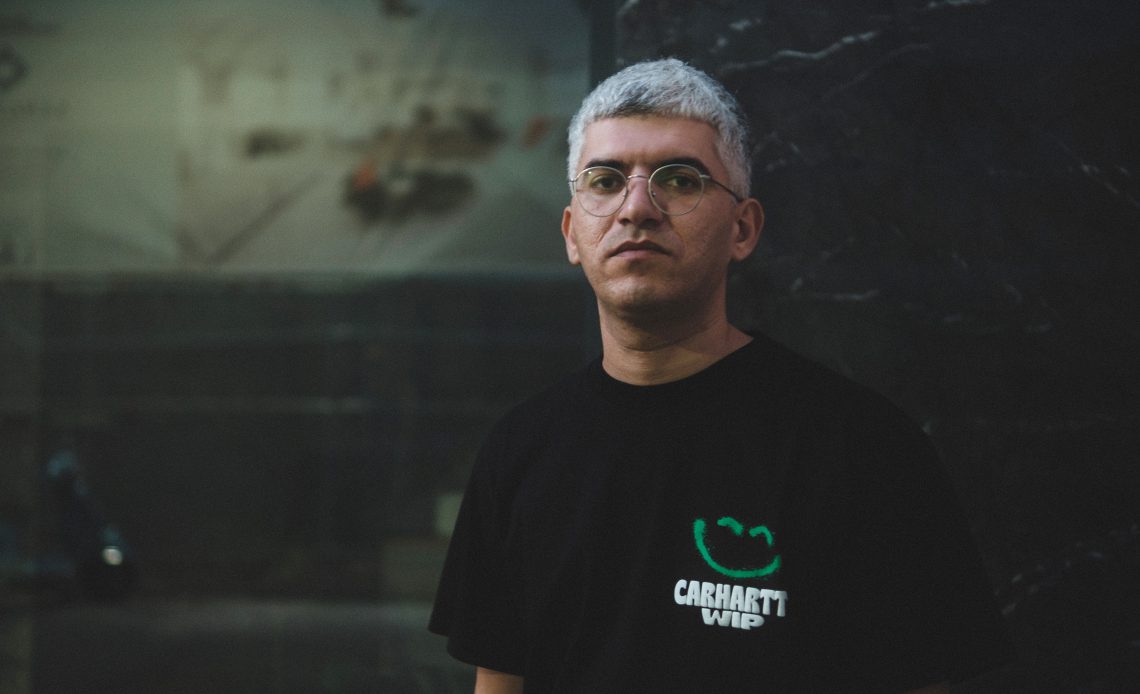The Vienna-based Palestinian artist and researcher Firas Shehadeh talks exclusively to Canvas about how his practice considers postcolonial thought in internet subcultures and the human condition in the digital age.
Your most recent work There, Where You Are Not (2022) explores the internet and digitality in connection with postcolonial thought. How did you first make this connection?
Politics and digitality were deeply connected in my development as a child. I grew up in Saudi Arabia close to the Kuwait border, playing Atari while watching my parents witness the Gulf War unfolding on TV. Later, around the time of the Second Intifada, we moved to Jordan, where we lived in a refugee camp. I was a nerdy kid who spent a lot of time gaming and developing websites locally on my PC. I was fascinated by the whole infrastructure of the internet. The political situation wasn’t just in the background – it was part of our lives.
Digitality comes up in your work in various ways. For example, your project Pure Life (2020) deals with the colonisation of ecosystems such as the Dead Sea. What was behind your choice to focus on the natural world?
The project deals with the exploitation of the native ecosystem. In 18th-century European knowledge systems, humans and nature were thought to have a binary relationship. ‘Humans’ referred to the white man, while nature was labelled ‘Other’ and applied to colonised peoples. The white man’s burden was to ‘civilise’ nature. On the other hand, Frantz Fanon, whose ideas I draw on in this project – and in fact all non-Enlightenment knowledge systems – viewed the environment as a single entity, a complex, intercommunicative ecosystem with multiple internal connections. This idea is part of Islamic, Indian, Chinese and Native American systems of thought as well. I also draw on Donna Haraway, who makes a similar argument through her idea of the ‘Chthulucene’.
Pure Life juxtaposes the worlds of digitality and nature to emphasise this idea that everything is connected, living and non-living things, and that’s what makes our planet livable. The Dead Sea is in danger because of a disruption to these connections. Researchers say it’s going to disappear by 2050, because Israel is exploiting the waters for its agricultural and cosmetics industries. This practice goes back to the colonial myth of ‘making the desert bloom’, used by the Zionist movement to justify the colonisation of Palestine. But making the desert bloom could pose problems to other areas. For example, dust carried on winds that blow from the arid Sahara to the luxuriant Amazon brings vital minerals that help enrich its ecosystem. If you make the Sahara ‘bloom’, you risk killing off the Amazon rainforest.
Tell us more about the influence of Donna Haraway on your work.
Haraway’s Staying with the Trouble (2016) and The Cyborg Manifesto (1985) have had a huge impact on me. Of course, she uses the cyborg as a metaphor for women’s bodies and their interaction with the patriarchal system. But I think this metaphor also applies to people of colour. People in the Global South have a much stronger connection with the internet and its subcultures, whereas the West is more in touch with high culture. Take cryptocurrency. Of course, there’s more investment in the West, but in Turkey for example, due to the lira crisis, people use crypto to sustain the economy. Or if you want to donate money to Gaza, you can’t use PayPal because the company considers it a ‘high-risk’ territory, so again, people use crypto.

You also co-curated Darat Al Funun’s online exhibition The Internet of Things: Another World is Possible, which looked at the prevalence of cyberspace during the early days of the Covid-19 pandemic. Did the exhibition draw from your own practice, and how?
Absolutely. When the pandemic hit and we went under lockdown, I became preoccupied with trying to articulate the new condition we were in. We didn’t have one step in the real world and one step in the virtual world, like before. And of course, there was a new virus, a word that relates to health and biology, but also to digitality. I co-curated the exhibition with Joud Tamimi and Reem Marji. Within the first week or 10 days of lockdown, Joud approached me and asked if I’d like to contribute. It was my first time curating a show. We spent hours every day for three weeks having conversations and reading about the topic. The title The Internet of Things connected two elements: the technical term that refers to a network of smart devices, and the idea that our bodies connect with those devices. We wanted to do it online because, with the pandemic, we were playing with different rules in a different game. It wouldn’t have made sense to host the exhibition in a physical art space.
Do you think memes can be considered an art form?
What makes art ‘art’ is the value and meaning it carries, how it engages, relates and communicates with our world and the human condition beyond descriptive language. The subreddit r/memes page — one of the biggest online memes platforms, with over 20 million users — defines them as “a way of describing cultural information being shared; an element of a culture or system of behaviour passed from one individual to another by nongenetic means, especially imitation”. As with post-conceptual art practices, memes deliver a critique, comment or reflection on the current socio-economic system and its productions – culture, taste, identity, politics.
You are participating in this year’s Singapore Biennale. What does your exhibit explore specifically?
I developed a new work entitled Signal Feels Collision (2022), commissioned by the biennale, which draws from my PhD research at the Academy of Fine Arts in Vienna. It explores the present postcolonial condition in which communities in the Global South use technology to communicate their reality to the world. I talk about this in relation to systems of abstraction like algorithms, which abstract human reality into digits in order to censor online content, and how colonised peoples resist them by adding a second layer of abstraction. For example, during the war in Gaza last year, Meta was censoring Palestinian content. Palestinians were using a kind of coded Arabic to navigate and bypass the algorithm – either Arabic script without diacritics, or ‘Arabizi’, Arabic sounds typed out in Latin letters with numbers.
What does Signal Feels Collision comprise?
It consists of eight digital prints on aluminum showing daily acts of resistance by Palestinians, to which I’ve added a layer of abstraction so you can’t see the images clearly. I’ve also composed a performance made up of sound elements relating to certain sub- cultural phenomena on the internet and in video games, as well as autotuned or remixed recordings of me reading from postcolonial texts like Edward Said’s 1978 book, Orientalism. I put all these elements together as a commentary on the human condition in the post-internet age, which is an enduring aspect of my work.
This interview first appeared in Canvas 105: Out of This World



